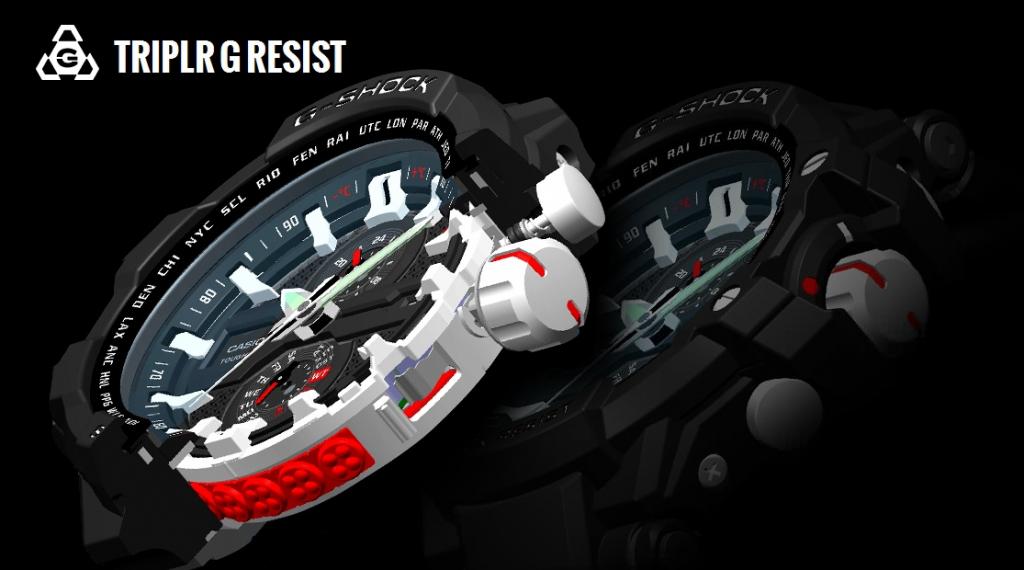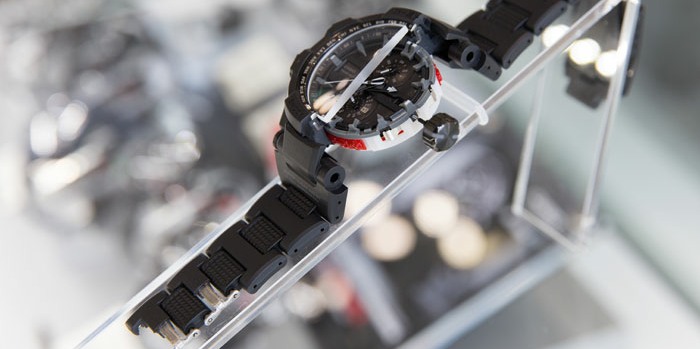Casio is nowadays a well-established watch brand on the global market, its success and recognition being mostly attributed to its G Shock range introduced in the early 1980’s. At a time when watches were fragile timekeeping instruments, which rarely survived any rough treatment! The G Shock distinguished itself from everything else by being the first unbreakable wristwatch. The only watch that no matter how many times it was dropped it would not break!
In getting to this stage Casio, although a relatively new name in the global watch manufacturing market, had taken a leap into the unknown and took upon itself the tremendous and ambitious task of upgrading the classic brittle watch that all other manufacturers at the time seemed to be happy with. Two years of continuous technical innovations in the redesigning of components and fitting processes, together with an 'outside the box' mentality, saw the G Shock born and presented to the world, who embraced it as a long awaited gift. Its designed ability to withstand shocks is a concept taken for granted nowadays. To achieve this the structure of the watch had to be redesigned in order to disperse the force of an impact outwards, without affecting the module suspended inside. A tough yet rubbery resin shell engulfed its exterior thus completing its 100% shock resistant structure. In addition to developing a shock resistant structure Casio also enhanced the water resistance feature of the new model to a 100 metres. Its innovation process had also led to an unprecedented extended battery life of up to10 years.

However, G Shock’s development team was not going to stop here, realising that they were barely scratching the surface in terms of the potential the new concept offered. The module itself was bound to be upgraded to levels previously unimaginable eventually incorporating basic functions such as thermometers and compasses to high tech features such as altimeters, barometer, moon phase and tide graph displays, radio receivers and ultimately GPS. The shock resistant structure constantly evolved as a direct result of its components being upgraded and revolutionary materials being utilized; such as titanium for its anti corrosive properties when in contact with salt water, carbon to increase the resistance coefficient of conventional straps, urethane membranes to prevent mud, dust or sand particles from penetrating the inner module, alpha gel that in addition to the shock resistance properties also rendered centrifugal and gravitational force resistance as well as vibration resistance. Eventually photo voltaic panels together with a rechargeable battery were incorporated thus eliminating the need of replacing the battery.

Having a multitude of functional features available and innovative high-tech materials with diverse properties enabled Casio to develop sub-ranges of the G Shock model.To start with they basically stripped down the watch to its basic form, reengineered its components and ultimately put them back together by suspending the module inside the newly designed shock dispersing case, and having it only secured at key points, this would enable the mechanism to be held apart from any shocks. The outside case was covered in a tough rubber resin matched to the redesigned structure of the case and applied to absorb the main force of any impact, in efffect the shock deflector. After 2 years of development Casio triumphantly presented to the world its first G Shock.
Casio had chosen to develop a shock resistant structure in order to protect the physical components. The course of development, however, proved to be more challenging than expected, and it was 2 years of painstaking trial-and-error and countless prototypes later, the G-Shock was finally created. The module was suspended in a hollow structure anchored at key points, which arrangement also increased its water resistance function. The intention had been to design a shock resistant case that would deflect and disperse any shocks towards the outside rather than directing it to the core, and therefore affecting the inside module. This they achieved by creating a hollow structure to house the module, then anchored it only in key points, thus leaving the module literally suspended inside the case. The redesigned hollow structure meant to house the module in relative suspension, would therefore eliminate the remaining impact force that was not absorbed and deflected by its exterior rubberised resin layer, the 'first line' of defence against shocks. This was also aided by a prominent bezel which had been engineered to protect the glass. The exterior of the watch also required extra protection, which resulted in the tough, rubbery resin layer; designed with the sole purpose of absorbing shocks. The newly designed shock resistant structure also incorporated a reliable water proof function which was sustainable up to a depth of 100 meters. At the time of the first G-Shock, other watches were at the mercy of gravity, 9 times out of 10 if accidentally dropped or hit that would have been the end of them.Equally devastating to other watches of the day was the threat of water damage to a watch; there was no layer of impermeability preventing it. Finally, it became apparent during the design process that battery life had to be upgraded as well; and given the energy limitations on ordinary watch batteries, they also had to be redesigned as the battery would have had to be replaced far too often for convenience. Unable to increase the batteries voltage, they had to reconfigure the power relay circuitry thus considerably diminishing the energy used and extending its operation period considerably.

In the early 1980’s Casio began looking to solve the 3 major obstacles watches were facing at that time: shock resistance, water resistance and battery life.Two years later Casio presented the first G-Shock to the world, and the rest, as they say, is history.
The path to the G Shock had not been an easy one; the universal laws of physics had previously meant that the structure of watches was fragile, water damage would also invariably mean getting a new watch and the batteries were not able to store sufficient energy to power watches for any reasonable period of time. The first G Shock, developed and released in the early 1980’s by Casio, completely revolutionised and literally “shocked” the watch industry world-wide by overturning the concept that watches as timekeeping devices are fragile and subjected to technical and physical limitations. Casio, overcoming these historical obstacles in watchmaking, reinvented the watch by aiming for a “Triple 10 concept” 10 meters’ free-fall resistance, 10 years’ battery life and 10 BAR water resistance, and named it “G Shock”.

Although nowadays we take innovations for granted, may even demand them and expect them to occur regularly, Casio literally shocked the world at tht time, through pure innovation in developing a concept of a triple 10 resistance watch - which the rest of us call a shock resistant watch. The G Shock redefined the watch industry world-wide with the release of the first model, it was an innovative concept and an impressive watch that raised the bar higher for watch manufacturers than it had ever been before.

 6000+ Reviews
6000+ Reviews



















